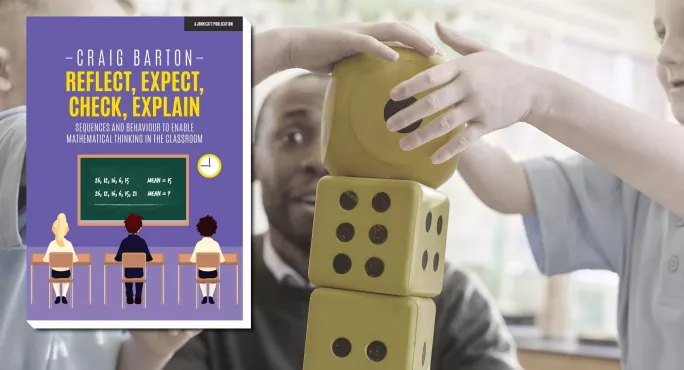- Home
- Book review: Reflect, Expect, Check, Explain
Book review: Reflect, Expect, Check, Explain

Reflect, Expect, Check, Explain: Sequences and behaviour to enable mathematical thinking in the classroom
Author: Craig Barton
Publisher: John Catt
Details: 500pp; £19.00
ISBN: 978-1912906345
At the opening of this follow-up to the well-received How I Wish I’d Taught Maths, Craig Barton explains that he feels that Reflect, Expect, Check, Explain is his “difficult second album”.
It might be stretching the metaphor to say that this is Nirvana’s Nevermind after Bleach, or the glorious Led Zeppelin II after - well, I’m probably mostly addressing maths teachers here, so I hope you can do the subtraction.
I’m pleased to report, however, that this is a powerfully argued, passionately communicated and well-researched work, which deserves to be read widely. Whether it will be is a question that policymakers must ask themselves.
Not content to rest on the laurels of his popular websites, Mr Barton Maths and Diagnostic Questions, Barton pioneered “same surface, different depth” (SSDD) problems, which have also been a great success. So far, so wonderful.
A passion for maths
But then came the pushback. With two collaborators, Jess Prior and Ben Gordon, Barton launched a site of new problems based on the “variation theory” that he had touched on in his first book. This site hosted resources focused on connected sequences of questions, where the small variations between chains of them teased out areas of misunderstanding.
Barton describes teachers’ rolling eyes when he presented these ideas, as well as snarky tweets bemoaning the regression of maths teaching to “boring worksheets”. He was hurt, and decided to take a long, hard look at his methods. This book is the fruit of that reflection.
Before looking in more detail at what it proposes (and, for transparency, I’ve never met or had contact with Barton), I think we ought to take a moment and thank him for the extraordinary amount of energy he has put into supporting mathematics teaching in this country, especially after the hurt of being labelled “the most dangerous and clueless man in education” by one detractor.
As outlined above, he has gifted the community of maths teachers an extraordinary number of resources across numerous sites. His work certainly makes my work easier. While there may be disagreements over some of his methods, it is incumbent upon us - especially in the era of too-easy tweeting - to appreciate the generous passion and commitment that goes into producing a book like this.
What we get inside is a closely argued and highly detailed exploration of variation theory, coupled with intelligent practice, to stir classes into real mathematical thought. Barton advises working through the material yourself, and I would suggest this, too, as it is only in the fine detail of variations in the sequences of questions he writes about that we see how they diagnose areas of weakness.
Codifying unconscious actions
As the title suggests, students are guided to reflect on what has changed between two questions in the sequence, and think about what they expect will happen to their answer. They then check, and then think about how to explain this change.
You are very likely to be doing a version of this already, but the beauty of a book like this is that by codifying what we have unconsciously been doing into a communicable practice, it enables us to refine our own methods, and to distil them into a system of thought that we can explicitly offer to students.
There is enough hand-holding here - walking through specifics of managing lessons using these techniques - to make this required reading for any NQT or trainee. The question is how well this material will sit with those, like me, who have been in the game for many years.
The resistance that Barton suffered when initially presenting his ideas on variation theory is instructive, because it perhaps speaks to a profession that has suffered initiative burnout.
In any Inset, the cynical-response reflex among exhausted and set-upon teachers is likely to be strong. So the challenge of a book like Barton’s is perhaps not whether teachers assimilate what is a smart set of practices, but whether they will be afforded an opportunity by schools to do so.
Denied time to be reflective practitioners, the rate of eye-roll response to these 500 pages of passionate articulation might be high. But the least that Barton deserves - having picked himself up from an online pasting and redoubled his commitment to explaining his ideas - is for us (and I write this as a busy and sometimes jaded head of maths) to take them seriously and try putting some of the ideas into practice.
The best accolade that I give the book is that giving it this time has already paid dividends. The learning rhythm of Reflect, Expect, Check, Explain that Barton proposes works. Variation theory is no silver bullet, but we know that there are no silver bullets in this game.
This is a rich feast, so get a copy and digest it slowly. Not everything will be to your taste, but you have to admire the work that has gone into bringing these ideas to the table.
Kester Brewin teaches maths in south-east London. While working as a teacher, he has been a consultant for BBC Education, and is the author of a number of books on culture and religion. He tweets @kesterbrewin
You can support us by clicking the book’s title link: we may earn a commission from Amazon on any purchase you make, at no extra cost to you
Keep reading for just £1 per month
You've reached your limit of free articles this month. Subscribe for £1 per month for three months and get:
- Unlimited access to all Tes magazine content
- Exclusive subscriber-only stories
- Award-winning email newsletters



